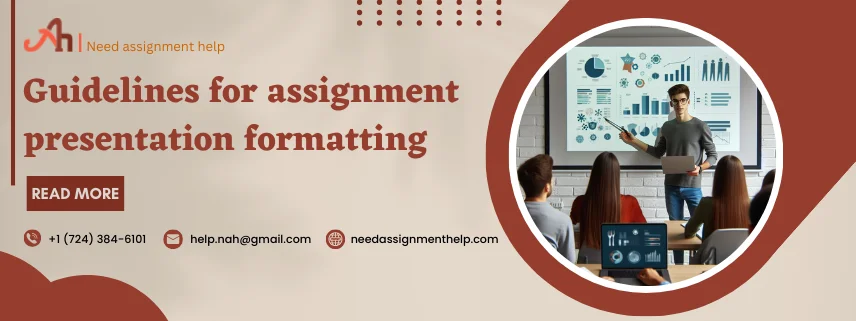


Presenting our work in a way that not only clearly conveys our thoughts but also demonstrates our expertise and attention to detail is a crucial skill that students must acquire. Not only is proper formatting important for presentational reasons, but it also guarantees clarity and consistency in information delivery. We’ll explore the unique aspects of assignment presentation formatting in this blog, taking advice from experts in the field and best practices.
Let’s examine the basic components of assignment presentation formatting before getting into the details. Among them are:
Consistency: Throughout your work, keep the font sizes, styles, alignment, and spacing identical.
Clarity: Be sure that the information you provide is rationally structured, easily readable, and well-organized.
Professionalism: Display your work in a presentable manner, being mindful of small issues like punctuation, grammar, and spelling.
Appropriateness: Format your assignment according to the guidelines that your lecturer or university has supplied.
The structure of your assignment plays a pivotal role in its presentation. Follow these guidelines to organize your content effectively:
Title Page: Add a title page with the assignment’s title, your name, the course title, the instructor’s name, and the submission date, among additional vital details. Follow any formatting guidelines that your university may have provided.
Table of Contents: Include a table of contents to give your work a roadmap if your assignment is extensive. Make sure the page numbers match the text and are accurate.
Introduction: Start with a clear and precise introduction that states the goal of the project and gives an overview of what to expect.
Main Body: Provide your points of view, analysis, or research methodically. To distinguish between several sections and preserve continuity, use headings and subheadings.
Conclusion: Summarize the key points of your assignment and reiterate your main arguments or findings. Avoid introducing new information in the conclusion.
References: Cite all of the sources you used for your assignment using a standard citation format (APA, MLA, etc.). Make sure the references are accurate and arranged alphabetically
Now, let’s delve into specific formatting guidelines to enhance the presentation of your assignments:
Font and Size: Choose a readable typeface with a standard size of 12 points, such as Arial, Times New Roman, or Calibri. Make sure that the font is used properly in the entire document.
Spacing: For the whole document, including the main body, quotations, references, and attachments, use double spacing. This makes the text easier to read and makes space for comments.
Margins: To provide enough white space and keep the page looking professional, set borders of one inch on every side of the document.
Alignment: The text should be aligned to the left margin, leaving the right edge uneven. Stay clear of justifying text, as this might lead to irregular spacing and problems with readability.
Headings and subheadings: To organize your content correctly, use headings and subheadings that provide context. For clarity, adhere to a hierarchical structure (e.g., Heading 1, Heading 2).
Paragraph Indentation: To make your writing look neat and professional, indent the first line of each paragraph by 0.5 inches. This makes it easier to identify paragraphs.
Page Numbers: Page numbers should be positioned with the right margin in the header or footer of each page. Beginning with the first page of the main body, number the pages.
Title Case: For uniformity and readability, capitalize the first letter of every keyword in titles, headers, and subheadings.
Adding visual components to your assignment might improve its clarity and presentation. Think about the following:
Tables and Figures: Tables and figures can be used to show important points or convey complex data. Make sure the text references, numbers, and labels are all properly indicated.
Charts and Graphs: To visualize quantitative information, use appropriate charts or graphs (like pie charts or bar graphs). Make sure they have clear labels and are easy to understand.
Images: When appropriate, use diagrams or pictures to further explain or bolster your points of contention. Make sure the pictures are clear and relate to the text.
Captions: Give tables, figures, and pictures concise captions that state their importance or source.
Before submitting your assignment, take the time to proofread and edit meticulously. Here are some tips:
Spelling and Grammar: Apply spell-checking software to find and fix errors in grammar and spelling. Furthermore, thoroughly proofread your assignment to identify any errors that may have gone unnoticed.
Clarity and coherence: Make sure that the writing you do is unified, clear, and short. Remove any unneeded terms or complex wording that might make the reader confused.
Consistency: Verify that the language, formatting, and citation style are all the same throughout your project.
Peer Review: To get useful guidance and pinpoint areas that require work, think about asking mentors or colleagues for their opinions.
Emphasis and Subordination: Make consistent and limited use of formatting styles like bold, italics, and underlining. Use italics to highlight words or titles, bold for headers and subheadings, and underlining to indicate hyperlinks or important points. Maintaining consistency in formatting styles enhances your document’s usability and visual attractiveness.
Bullet Points and Numbered Lists: To make complex material easier to understand, use bullet points or numbered lists. Numbered lists work well for stages or sequences, whereas bullet points work well for listing objects that don’t have to be in a certain order. For coherence and clarity, make sure every list has a parallel structure and succinct language.
Alt Text for Images: Provide alternate text, or alt text, for any photos, charts, or graphs you use in your project to make them accessible to readers who are blind or visually impaired. The objective of alt text is to succinctly explain the picture’s content so that readers who are unable to view the image directly may still comprehend its relevance.
Color Contrast: When using color in your work, be mindful of the contrast between the text, backdrops, and charts. To make the text easier to read, especially for readers who have color vision impairments, make sure there is enough contrast between the text and backdrop colors. To make the text easier to understand and make sure that all readers can see it, aim for a strong contrast.
You may further improve the work’s accessibility, clarity, and professionalism by including these extra points in the structure of the task’s presentation. When formatting assignments, keep in mind that uniformity, simplicity, and accessibility should be given top priority to produce work that successfully communicates your ideas and has an impact on your audience.
Disclaimer: To be clear, this blog was generated with the assistance of an AI program. A human has reviewed, revised, supplemented, and rewritten parts of this content.
Formatting plays a crucial role in enhancing the readability, clarity, and professionalism of your assignment. Consistent formatting ensures that your content is well organized, easy to follow, and visually appealing, thereby facilitating effective communication of your ideas.
To maintain consistency, use a standard font style and size (e.g., Arial, Times New Roman, 12 points) and adhere to uniform spacing, alignment, and indentation. Follow a hierarchical structure for headings and subheadings, and ensure that formatting styles (e.g., bold, italics) are applied consistently.
Yes, incorporating visual elements can enhance the presentation and clarity of your assignment. Use tables and figures to present data, charts or graphs to visualize quantitative information, and images or diagrams to support your arguments or provide context. Ensure that all visual elements are relevant, clearly labeled, and properly referenced in the text.
To ensure accessibility, provide alternative text (alt text) for images to assist visually impaired readers in understanding the content. Pay attention to color contrast when using color elements to ensure readability for all readers, including those with color vision deficiencies. Additionally, use headings, bullet points, and numbered lists to facilitate navigation and comprehension for all audiences.
To proofread and edit your assignment effectively, utilize spell-checking software to identify and correct spelling and grammar errors. Read through your assignment carefully to ensure clarity, coherence, and consistency in formatting and terminology. Consider seeking feedback from peers or mentors to gain valuable insights and identify areas for improvement before submission.